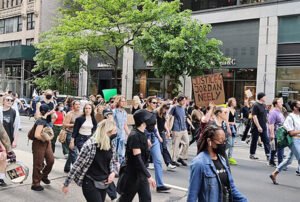
According to the 2022 agriculture census from the US Department of Agriculture (USDA), 24,000 factory farms in the United States currently raise 1.7 billion animals a year in concentrated animal feeding operations. This marks a 6 percent increase since 2016 and an almost 50 percent rise over the past 20 years.
Not only are these animals housed in extremely inhumane conditions, which harms animal immune systems and endangers public health, but factory farms also exacerbate climate change and violate labor rights. While the COVID-19 pandemic made visible the racism, abuse, and unsafe working conditions experienced by meatpacking workers, these issues existed long before the pandemic and continue to deteriorate.
The intersection of animal and human wellbeing makes it imperative for animal welfare advocates to build solidarity with workers to achieve liberation for both human and nonhuman animals.
Slaughterhouse and Meatpacking Workers
According to the Food Chain Workers Alliance, 65 percent of meatpacking and food processing workers have experienced job-related injuries.
Slaughterhouse and meatpacking workers are chronically underpaid. Annual wages average $28,450, just above the federal poverty line for a family of four, despite these jobs being highly dangerous. Employees are regularly denied bathroom breaks and, if undocumented, are threatened with deportation when they voice concerns. They often face emotional abuse and humiliation from managers.
Workers in this sector are predominantly Black and Latinx, and many are immigrants and refugees. Only around 25 percent of them reside in households where all members aged 14 or above are proficient in English. Immigration status, English proficiency level, and economic precarity make these workers extremely exploitable.
Past investigations into meatpacking plants have underscored how companies consistently prioritize profits over safety and worker health. Increasing line speeds, in which workers are pressured to kill more animals in less time, along with long hours and repetitive motions, significantly increase the risk of injury. As a result, workers often experience chronic pain in their hands, wrists, arms, shoulders, and back. Under the intense pace at which most facilities operate, repetitive stress injuries become inevitable, according to the Food Empowerment Project (FEP).
In fact, according to the Food Chain Workers Alliance, 65 percent of meatpacking and food processing workers have experienced job-related injuries. Additionally, data reported to the Occupational Safety and Health Administration (OSHA) in 2015 indicated that amputations and hospitalizations are common at Tyson Foods meatpacking plants, although the FEP says that the rate of workplace injuries may be much higher because of a culture of underreporting injuries.
Children have increasingly been victims of this industry. In 2023, the US Department of Labor (DOL) found 5,792 instances of children being illegally employed—an 88 percent increase since 2019. Many of these incidents included employing children to clean slaughterhouse facilities, including “dangerous kill floor equipment such as head splitters, jaw pullers, meat bandsaws, and neck clippers,” in violation of federal law.
Unfortunately, numerous incidents have led to fatalities. In July 2023, at least three children died from work-related injuries at US animal slaughter facilities. One of these tragic cases involved 16-year-old Duvan Tomas Perez, who died at a Mississippi poultry plant after being trapped in conveyor belt equipment. His death led OSHA and the DOL to investigate the incident, which marked the plant’s second fatality in two years.
Earlier, in February 2023, a DOL Wage and Hour Division investigation revealed that over 100 children were illegally employed in hazardous jobs. Packers Sanitation Services Inc., one of the nation’s largest food safety sanitation companies, was found to have employed children at 13 meat processing facilities in eight states, including those of Tyson Foods, JBS Foods, and Cargill. Many of these minors worked in dangerous occupations and routinely had to work overnight shifts. The DOL fined Packers Sanitation Services Inc. over $1.5 million for violating the Fair Labor Standards Act (FLSA) by employing 102 children illegally; the fine of $15,138 per minor illegally employed was the maximum allowed by law. But for a company that is worth close to $1 billion, the fine is a minor cost of doing business.
Throughout the industry, child labor appears to be on the rise. In fact, the DOL reports that child labor incidents have increased by 69 percent between 2018 and 2022.
Necropolitics, Speciesism, and Carceral Capitalism
“Necropolitics” refers to using social and political power to determine who lives, who dies, and how someone should live or die. In “Zombification, Social Death, and the Slaughterhouse: U.S. Industrial Practices of Livestock Slaughter,” S. Marek Muller, building on the work of political theorist Achille Mbembe, describes necropolitics as the state’s ability to render certain bodies killable, such as by designating enslaved people as “chattel” to strip them of their personhood and legal rights to life and liberty.
Muller uses the term “zombification” to express the social process in which one “becomes socially dead physically, psychologically, and culturally.” Muller explores how the nonhuman animal agriculture industry not only “places animals in the role of the ideal socially dead subject (the chattel slave)” but also animalizes the human workers. In other words, under racial and carceral capitalism, necropolitics renders nonhuman animals as “slaughter-able” while humans are viewed as animals.
Racial capitalism, a term developed by the late Black Marxist scholar Cedric Robinson, posits that “racialized exploitation and capital accumulation are mutually reinforcing.” Similarly, scholars like Jackie Wang have asserted that racial capitalism is deeply entangled with carceral systems which “are shaped by—and work in tandem with—the imperatives of global capitalism.” In this context, a carceral and racial capitalism framework allows us to consider how this system transforms human and nonhuman bodies into commodities whose labor is consumed and capitalized upon by the elite class.
One example of this occurred in April 2020 when managers at Tyson Foods organized a “winner-take-all betting poll,” wagering on how many employees at a meatpacking plant in Waterloo, IA, would contract COVID-19. As the virus devastated the meatpacking industry that month, Tyson officials chose to keep the Waterloo plant open. Ultimately, an outbreak infected over 1,000 workers. Company-wide at Tyson, by May 2020, 4,600 workers were infected by the virus, and 18 had died.
The animal advocacy movement has a history of…“[using] the State to protect animals through forms of violence [that harm] workers at meat packing plants.”
Sign up for our free newsletters
Subscribe to NPQ's newsletters to have our top stories delivered directly to your inbox.
By signing up, you agree to our privacy policy and terms of use, and to receive messages from NPQ and our partners.
As Muller explains, embedded deeply within this necropolitical racial and carceral capitalist system is speciesism, the assumption that individuals deemed (fully or solidly) “human” are superior to other(ed) individuals, both human and nonhuman, who are deemed “animals.” Speciesism is inherently hierarchical and simultaneously justifies the exploitation of nonhuman animals and animalized humans, rendering their suffering relatively invisible and unquestioned. Industrial agriculture relies on the entanglement of speciesism with White supremacy and racial capitalism, which depend on a hierarchized relationship between race, animality, and humanity.
As Syl Ko explores in APHRO-ISM: Essays on Pop Culture, Feminism, and Black Veganism from Two Sisters, humanness is a “certain way of being, especially exemplified by how one looks or behaves, what practices are associated with one’s community, and so on…this means that the conceptions of ‘humanity/human’ and ‘animality/animal’ have been constructed along racial lines.”
Similarly, racism’s “ontological plasticity,” as posited by Zakiyyah Jackson in Becoming Human: Matter and Meaning in an Antiblack World, “render[s] one’s humanity provisional.” In other words, White supremacy constructs and relies on a social malleability of racialized people and its entanglements with surveillance, control, and carcerality to extract capital from its laborers. In this racial capitalist landscape, meatpacking workers experience ontological plasticity, being simultaneously human and nonhuman: human as legal “employees” of a company and nonhuman as “killable” commodities.
The Need to Move Away from Carceral Veganism
The animal advocacy movement has a history of relying on carceral veganism, which Riley Clare Valentine defines as “a form of veganism which uses the State to protect animals through forms of violence in which workers at meat packing plants are at high risk of both…imprisonment as well as potential deportation.” This often takes the form of raids on facilities. Not only do these raids, often carried out by Immigration and Customs Enforcement (ICE) officials, harm those targeted, but they have allowed the meat companies to blame a couple of “bad apples” and avoid being held accountable for systemic harm to animals, workers, and the environment. Similarly, Hailey Huget in Current Affairs has criticized the animal advocacy movement for implementing carceral vegan tactics to “treat workers in animal agriculture as scapegoats.”
These themes are explored in depth by a number of leading activist-scholars in a book I edited, published this year by Peter Lang, titled Building Multispecies Resistance Against Exploitation: Stories from the Frontlines of Labor and Animal Rights. In that volume, Muller asserts that the animal advocacy movement must consider ways in which it has also been complicit in animalizing and marginalizing workers:
The pursuit of animal liberation calls for a critical interrogation of how best to liberate the human and nonhuman animal victims of this industry, how to problematize processes of dehumanization and animalization. This process must also involve a critical interrogation of how animal liberationists themselves “animalize” other humans (such as slaughterhouse workers) specifically to deny them empathy, concern, and moral consideration.
Solidarity [with workers could] transform nonhuman animal liberation “from a single cause into a mass movement.”
Not only has the animal advocacy movement regularly worked with police and prosecutors to investigate and criminalize workers, but Ellyse Winter asserts that the use by animal advocacy nonprofits such as People for the Ethical Treatment of Animals (PETA) and Mercy for Animals (MFA) of undercover investigations “utilize a surveillance and detention framework that often targets marginalized farm and slaughterhouse workers.”
Moreover, as Kelly Shanahan writes:
The effect of the animal protection movement’s sole focus on animal abuse and resulting desire for individual carceral punishment compounds the abuses that workers suffer in the meatpacking industry. By being set on punishing meatpacking workers for animal abuse, animal protection groups miss the opportunity to attack the predatory practices of the meatpacking industry.
Toward Nonhuman Animal Liberation and Worker Liberation
The animal advocacy movement stands at a pivotal juncture—meat consumption is at an all-time high, and the movement has alienated various communities by championing the rights of nonhuman beings while overlooking the needs of marginalized human populations. This has resulted, at times, in a focus on alleviating the suffering of animals at the expense of marginalized communities and, at its worst, collaborating with the carceral system to the detriment of vulnerable meat industry workers.
The authors in Building Multispecies Resistance Against Exploitation address this theme as well. Huget, for her part, calls on the animal advocacy movement to build solidarity between the animal advocacy and labor movements and transform nonhuman animal liberation “from a single cause into a mass movement” that incorporates “tactics that also use worker-power, community-power, and citizen-power.”
Huget suggests that this could look like rallying voters behind bills such as the Farm System Reform Act or organizing within workplaces and communities affected by the meat industry to pave the way for actions such as strikes and boycotts. This alternative approach to nonhuman animal liberation helps establish tangible links with other movements advocating for institutional abolition, such as those aimed at police/prison abolition and the dismantling of immigration enforcement agencies like Immigration and Customs Enforcement (ICE).
While some in the animal advocacy movement have been hesitant to adopt Huget’s approach, there is tangible progress. Will Boisseau, for example, points to the labor rights organization Venceremos, which organized the first strike of poultry workers in Arkansas. Magaly Licolli, a cofounder of the group, told Boisseau that “the struggle should be unified.” Boisseau also points to the Animal Legal Defense Fund’s July 2020 whistleblower campaign and Food & Water Watch’s complaint to the Federal Trade Commission regarding worker safety at Tyson.
Additional examples come from the Food Empowerment Project and Apex Advocacy. These groups, both BIPOC-led, work toward the liberation of nonhuman animals within a social justice frame, prioritizing the needs of those most impacted by systemic oppression. Apex, in particular, has published statements calling out the animal advocacy movement for dehumanizing slaughterhouse workers; being shaped by sexist culture and protecting men in the movement who engage in sexual misconduct; and, more recently, remaining silent on the current genocide in Palestine.
“Solidarity campaigns bringing together workers and animal rights will not be easy to build,” Boisseau warns. However, examples like those above show that solidarity is possible. By building power with labor rights organizations like Vencermos, the goal of animal and human liberation becomes far more attainable.












